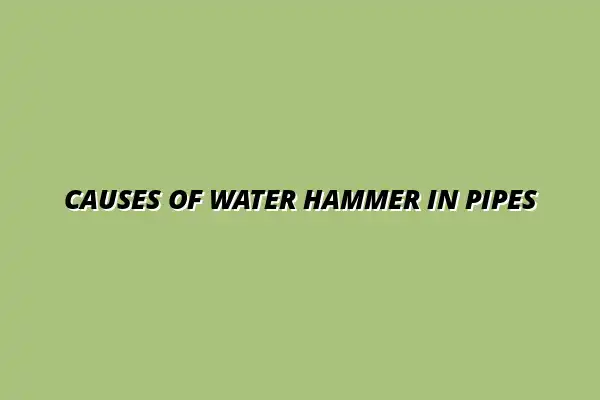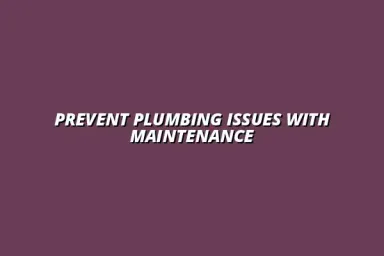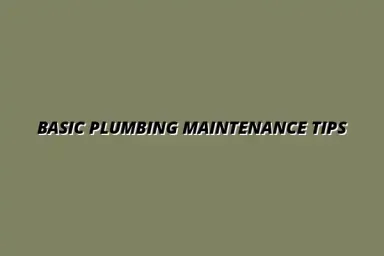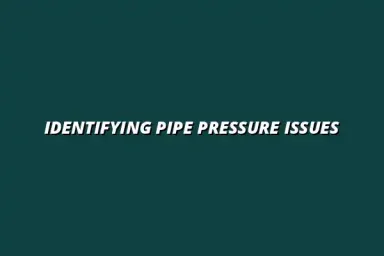Understanding Water Hammer and Its Implications
Water hammer is a phenomenon that many homeowners encounter but might not fully understand. It refers to the loud banging or thumping noises in your plumbing system when water flow suddenly changes. This issue can lead to more serious problems if not addressed promptly, making it crucial to grasp what causes it and how it can affect your home’s plumbing.
When discussing water hammer, it’s essential to be aware of the implications it can have on your plumbing system. Ignoring the symptoms may lead to damaged pipes, expensive repairs, and even compromised appliances. For example, understanding the causes of bursting water pipes can help prevent serious damage. Therefore, understanding water hammer starts with identifying its symptoms and the underlying causes.
Defining Water Hammer: What Happens in the Pipes?
At its core, water hammer occurs when water flowing through the pipes is abruptly stopped or redirected. This sudden change in motion creates a pressure wave that travels through the plumbing, causing vibrations and noise. It’s a bit like slamming on brakes in a car — the sudden stop creates a jolt that can be felt throughout the vehicle.
The science behind water hammer can be summed up in a few key elements. When a valve closes quickly, the momentum of the moving water doesn’t just stop; it pushes against the walls of the pipe, generating pressure fluctuations that can manifest as noise and stress on the plumbing. Learning more about noisy water pipes, their causes, and solutions is vital to diagnosing and addressing water hammer effectively.
The Science Behind Water Hammer: Pressure Fluctuation Explained
Pressure fluctuations are the heart of water hammer. When water flow is interrupted, the stored energy in the moving water leads to a rapid change in pressure, which can create loud banging noises. This reaction can be even more pronounced in older plumbing systems where the materials may not absorb shock as well as newer ones.
Factors like pipe material, diameter, and length can also influence how severe the water hammer effect will be. Knowing these details can help homeowners identify potential issues and take steps to mitigate them. In particular, softer materials can absorb shock better than rigid ones. Problems in your kitchen plumbing, for example, can often be a source of water hammer. Check out this guide on common kitchen plumbing issues for more information.
Common Symptoms of Water Hammer in Household Plumbing
Homeowners may notice a few distinct signs of water hammer in their plumbing. Here are some common symptoms to watch for:
- Loud banging noises when faucets or appliances are turned off.
- Vibrations felt through pipes or fixtures.
- Unusual fluctuations in water pressure.
If you start to notice these symptoms, it’s a strong indicator of water hammer. Ignoring these sounds and sensations can lead to more significant plumbing issues down the road, so it’s essential to address them as they arise. Regular inspections of your bathroom plumbing are also vital for early detection of problems. Learn more about the importance of regular bathroom plumbing inspections.
Identifying Key Components Contributing to Water Hammer
Understanding the components that contribute to water hammer can help homeowners take proactive measures. Various factors play a role in how water hammer manifests, including the material and diameter of the pipes. Knowing which elements are at play can lead to targeted solutions that address the root causes.
Let’s explore some critical components that can affect the likelihood of experiencing water hammer in your plumbing system. By identifying these factors, you can better prepare for and mitigate water hammer issues. Noisy water heaters are a common plumbing problem; this guide will help you to troubleshoot noisy water heaters.
The Role of Pipe Material and Diameter in Water Hammer Occurrence
The material and diameter of your pipes significantly influence the occurrence of water hammer. Common pipe materials include copper, PVC, and galvanized steel. Each type has its own unique properties that can either exacerbate or reduce the effects of water hammer.
For instance, narrower pipes can lead to higher water velocities, which increases the chances of pressure surges. Conversely, larger diameter pipes may help dissipate the energy more effectively, reducing the impact of sudden changes in flow. Understanding these factors can empower homeowners to make better decisions about their plumbing systems. If you're experiencing plumbing issues in Birmingham, consider contacting a plumber in Billesley, Birmingham.
Impact of Water Supply Pressure on Water Hammer Risks
Water supply pressure also plays a crucial role in the risk of water hammer. If your home’s water pressure is higher than normal, it can amplify the effects of water hammer when a valve closes quickly. This situation can lead to more severe banging noises and potential damage over time.
Homeowners should regularly check their water supply pressure to ensure it falls within recommended levels. Typically, the ideal pressure range is between 40 and 60 psi. If your pressure exceeds this range, consider installing a pressure-reducing valve to help manage the flow and minimize risks associated with water hammer. Remember to take steps to prevent frozen pipes this winter to avoid further plumbing problems.
Addressing Water Hammer: Potential Solutions and Preventative Measures
Dealing with water hammer can be a bit tricky, but there are effective techniques to help reduce its effects. Understanding these solutions not only protects your plumbing system but also enhances the comfort of your home. By implementing the right strategies, you can minimize the noise and damage associated with this common plumbing issue.
Effective Techniques for Reducing Water Hammer Effects
One of the best ways to tackle water hammer is by installing water hammer arrestors. These devices work by absorbing the shock that occurs when water flow is suddenly stopped, preventing those annoying noises in the pipes. Additionally, they can be installed relatively easily and provide a lasting solution to the problem.
- Benefits of water hammer arrestors include:
- Enhanced comfort from reduced noise
- Protection of plumbing fixtures
- Long-term durability and effectiveness
Another vital strategy involves adjusting water pressure in your home. Finding the right balance in water pressure can significantly lessen the risk of water hammer. Aim for a pressure range between 40 and 60 psi for optimal safety and performance.
Installing Water Hammer Arrestors: Benefits and Considerations
When choosing water hammer arrestors, it’s essential to consider various factors, such as the size and type of your plumbing system. For instance, smaller systems might require smaller and fewer arrestors, while larger systems may need more robust solutions. Furthermore, it's beneficial to consult with a plumbing professional to ensure proper installation.
Most water hammer arrestors are designed to last for years, but regular checks can ensure they function as intended. If you notice persistent hammering sounds despite having an arrestor, it may indicate a more significant issue that needs addressing.
Adjusting Water Pressure: Finding the Right Balance
Maintaining the right water pressure not only reduces water hammer but also prolongs the life of your plumbing fixtures. Too high of a water pressure can lead to wear and tear, while too low can cause other plumbing issues. Keep an eye on your water pressure readings using a pressure gauge and make adjustments as needed.
- Steps for adjusting water pressure:
- Check your current water pressure with a gauge
- Locate the pressure-reducing valve (PRV) if applicable
- Turn the adjustment screw to increase or decrease pressure
Routine Maintenance Practices to Prevent Water Hammer
Regular plumbing inspections are crucial for catching potential issues before they escalate. These inspections can help detect problems like worn fixtures or improper pipe alignment that may contribute to water hammer. It’s wise to schedule a professional check at least once a year.
- Benefits of routine maintenance include:
- Early detection of plumbing issues
- Extended life of your plumbing systems
- Peace of mind knowing your home is secure
In addition to inspections, maintaining and replacing air chambers can significantly contribute to minimizing water hammer. Air chambers can become waterlogged over time, which reduces their ability to cushion pressure changes. Regularly checking and replacing these components when necessary will keep your plumbing healthy.
Importance of Regular Plumbing Inspections for Early Detection
Regular inspections can help identify not just water hammer issues but also other plumbing concerns like leaks, corrosion, or blockages. Catching these problems early can save you significant time and expense in repairs down the road. It's always better to be proactive than reactive!
Consider keeping a log of maintenance steps taken and any plumbing concerns observed during inspections, as this will provide valuable information for your plumber during visits.
Maintaining and Replacing Air Chambers: Best Practices
To ensure air chambers function well, it’s essential to keep them clean and free from debris. If you notice water hammer symptoms despite having air chambers installed, they may need to be replaced. Here are some best practices for maintaining air chambers:
- Check for waterlogging regularly
- Flush the air chambers if they become clogged
- Consider replacing them every few years for optimal performance

 Kiran Almasi
Kiran Almasi

